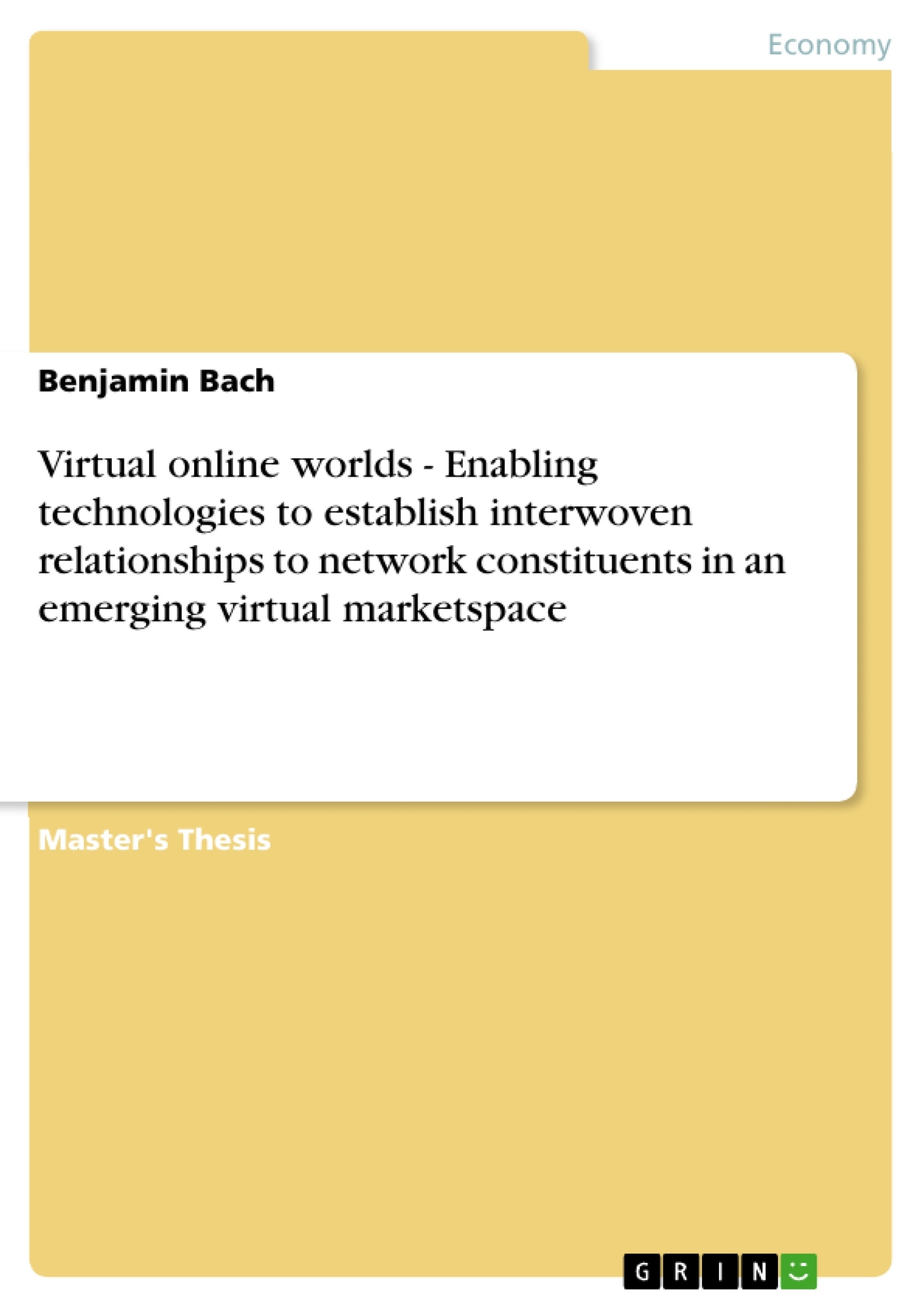Purpose
This dissertation analyses whether Second Life, as an emerging interactive
online environment, provides marketers with the scope to establish
interwoven relationships to network constituents, and highlights the
importance and benefits arising from enabling technologies to business
marketing operations.
Design / Methodology / Approach
The correlation to previous work was critically addressed with a focal point
set on relationship, and e-marketing approaches and strategies, whilst
highlighting the potential of an utilisation of virtual worlds / communities.
The methodological approach was of an inductive philosophy by
gathering information about Second Life from a corporate and an
individual point of view. This took the form of a self-administered Internetmediated questionnaire, a semi-structured telephone interview and a
participant observation.
Findings
Through a conceptual analysis of the virtual community of Second Life in
terms of exploring reasons for participation and benefits received from an
immersion into Second Life, the research study indicated that corporate
involvement in this innovative environment can offer marketers with
opportunities to establish relationships to existing and potential network
constituents.
Research Limitations / Implications
This marketing research study identified limitations due to its topical nature,
as the number of research publications is limited with regards to the
momentum of Second Life’s innovative virtual 3-D environment and hence,
research in this arena is only just emerging and has not been empirically
tested. The evolving virtual world environment along with the possible
necessity for marketers to both establish a presence and demonstrate
innovative marketing approaches to capture a tech-savvy audience,
identify the implications for this dissertation.
Inhaltsverzeichnis (Table of Contents)
- Abstract
- Purpose
- Design / Methodology / Approach
- Findings
- Research Limitations/ Implications
- Practical Implications
- Originality / Value
- Introduction
- Chapter 1: Theoretical Framework
- 1.1 The Concept of Relationship Marketing
- 1.2 The Importance of Network Constituents
- 1.3 E-Marketing and Enabling Technologies
- 1.4 The Emergence of Virtual Worlds and Communities
- Chapter 2: Second Life as an Evolving Virtual Community
- 2.1 Introduction to Second Life
- 2.2 The Concept of Virtual Worlds
- 2.3 Understanding the Second Life World
- Chapter 3: Exploring the Motivation and Benefits of Participation in Second Life
- 3.1 Reasons for Participation
- 3.2 Benefits Received from Participating in Second Life
- Chapter 4: Research Methodology and Analysis
- 4.1 Qualitative Research Methodology
- 4.2 Research Design
- 4.3 Data Collection Methods
- 4.4 Data Analysis
- Chapter 5: Findings and Analysis
- 5.1 Exploring the Corporate Perspective
- 5.2 Exploring the Individual Perspective
- 5.3 Discussion and Analysis of the Findings
- Chapter 6: Implications for Marketers and Conclusion
Zielsetzung und Themenschwerpunkte (Objectives and Key Themes)
This dissertation examines whether Second Life, as an emerging interactive online environment, offers marketers opportunities to build strong relationships with network constituents. It emphasizes the significance and advantages of enabling technologies for business marketing operations. The main themes and objectives of this research include: * Exploring the potential of virtual worlds like Second Life as platforms for relationship marketing. * Analyzing the benefits of enabling technologies in facilitating relationships between marketers and network constituents. * Investigating the motivations and advantages of participating in Second Life from both corporate and individual perspectives. * Understanding the implications of virtual worlds like Second Life for traditional marketing practices. * Examining the role of virtual communities in the evolving landscape of e-marketing.Zusammenfassung der Kapitel (Chapter Summaries)
Chapter 1: Theoretical Framework
This chapter provides a foundation for the research by exploring key concepts related to relationship marketing, the importance of network constituents, the role of enabling technologies in e-marketing, and the emergence of virtual worlds and communities.Chapter 2: Second Life as an Evolving Virtual Community
This chapter introduces Second Life as a specific example of a virtual world, explaining the concept of virtual worlds in general and then delving into the unique characteristics and features of Second Life.Chapter 3: Exploring the Motivation and Benefits of Participation in Second Life
This chapter examines the reasons why individuals choose to participate in Second Life and the benefits they derive from their participation. It explores the motivations and advantages from both a corporate and individual perspective.Chapter 4: Research Methodology and Analysis
This chapter outlines the qualitative research methodology employed in this study, including the research design, data collection methods, and data analysis techniques.Chapter 5: Findings and Analysis
This chapter presents and analyzes the findings of the research, exploring the perspectives of both corporations and individuals regarding their involvement in Second Life.Chapter 6: Implications for Marketers and Conclusion
This chapter summarizes the key findings and discusses the implications of the research for marketers. It concludes by highlighting the potential of virtual worlds like Second Life for relationship marketing strategies and the importance of integrating enabling technologies into marketing operations.Schlüsselwörter (Keywords)
This dissertation focuses on the intersection of virtual worlds, relationship marketing, and enabling technologies. Key themes include Second Life, virtual communities, e-marketing, network constituents, customer relationship management (CRM), interactive communication, and the implications of emerging technologies for marketing practices.- Citation du texte
- MSc International Marketing Strategy Benjamin Bach (Auteur), 2007, Virtual online worlds - Enabling technologies to establish interwoven relationships to network constituents in an emerging virtual marketspace, Munich, GRIN Verlag, https://www.grin.com/document/113517



